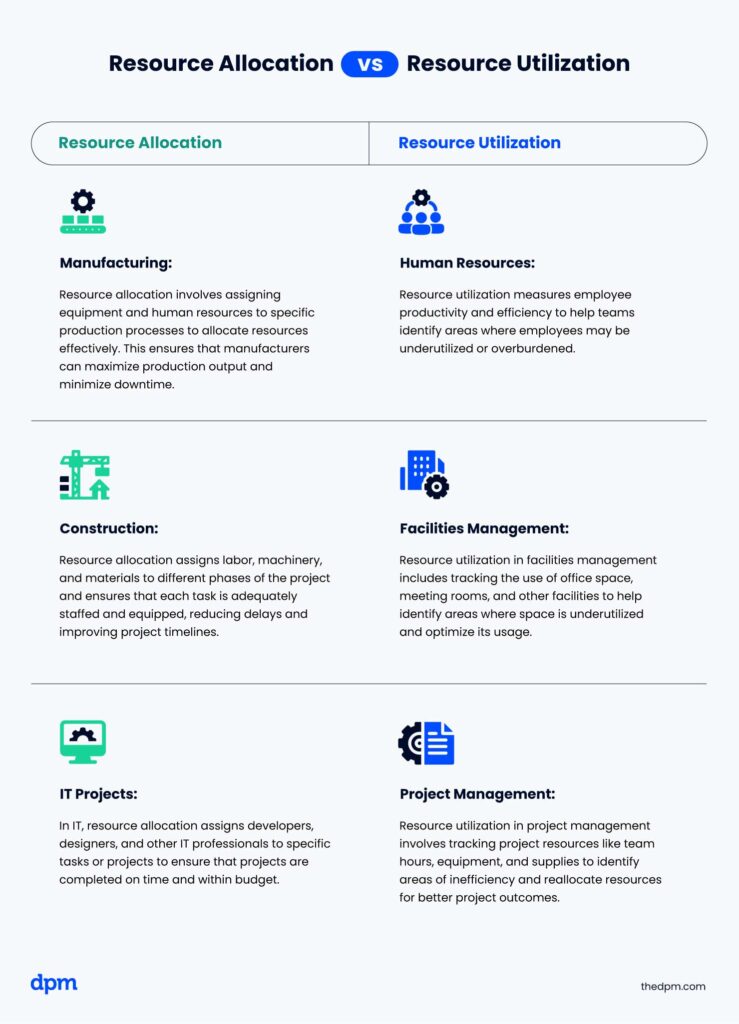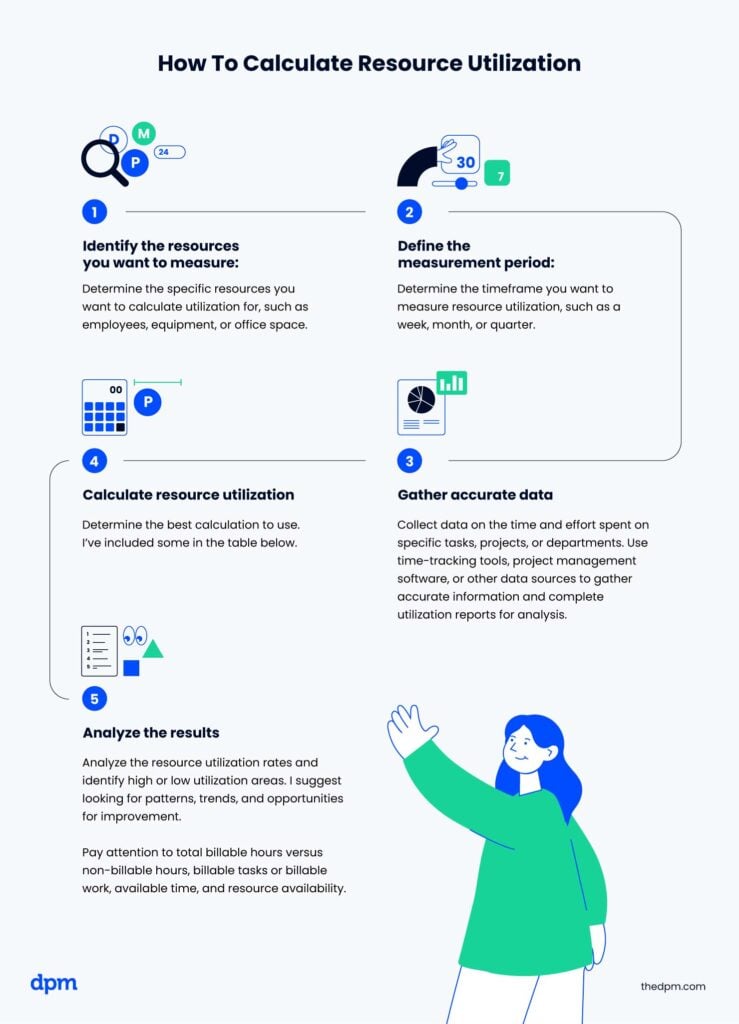Efficient resource utilization means knowing how much work is on each team member’s plate, and it’s crucial for businesses to stay competitive and profitable. The ideal utilization rate should be between 70 and 80%. Achieving this may seem complex, but it can be done with simple calculations and best practices that I’ll share.
What is Resource Utilization?
Resource utilization is the calculation of how efficiently your organization's resources—including human resources, equipment, time, and other assets—are being used to achieve its objectives.
It helps you identify inefficiencies, make more informed decisions about resource allocation, and improve overall productivity and the bottom line.
Project managers also use resource utilization to maximize their team's time and output, reduce costs, and minimize waste.
Why Is Resource Utilization Important?
Resource utilization is important because it provides visibility into the overall health of your projects and organization and helps identify areas of inefficiency and waste. It can also signal that your business or project resources are overworked.
Resource utilization is important for the following reasons:
- Bottlenecks: If resources are overperforming in one area and underperforming in another, it could lead to bottlenecks that disrupt workflow and compromise deliverables.
- Increased turnover: When utilization rates are too high, teams suffer burnout and tend to seek opportunities elsewhere, creating more significant resourcing problems.
- Low morale: Whether you have under or over-utilized resources, team members can experience low morale, which can, in turn, reduce productivity.
- Low productivity: This is a sign of underutilization, which, if not addressed, can lead to bottlenecks, low morale, turnover, and lost productivity altogether.
- Low profitability: Increased turnover, low morale, decreased productivity, and poor decision-making are all factors that ultimately impact profitability.
As a project manager, you should proactively monitor utilization to identify potential issues before escalating.
For example, if a specific department consistently shows low utilization, it may indicate a need for additional training or restructuring. By addressing these issues promptly, businesses can prevent them from negatively impacting productivity and profitability.
Resource Allocation vs Resource Utilization
Resource allocation is the process of assigning and delegating the right resources to specific tasks or projects, and it involves specific resource allocation methods.
It determines which resources are needed and when to achieve desired outcomes, whereas the utilization of resources measures how effectively those allocated resources are being used. It compares the actual usage of resources against their available capacity.
Resource allocation and utilization are related concepts and are crucial for optimizing operations. Here are a few use cases for each.
Use resource allocation for:
- Manufacturing: Resource allocation involves assigning equipment and human resources to specific production processes to allocate resources effectively. This ensures that manufacturers can maximize production output and minimize downtime.
- Construction: Resource allocation assigns labor, machinery, and materials to different phases of the project and ensures that each task is adequately staffed and equipped, reducing delays and improving project timelines.
- IT projects: In IT, resource allocation assigns developers, designers, and other IT professionals to specific tasks or projects to ensure that projects are completed on time and within budget.
Use resource utilization for:
- Human resources: Resource utilization measures employee productivity and efficiency to help teams identify areas where employees may be underutilized or overburdened.
- Facilities management: Resource utilization in facilities management includes tracking the use of office space, meeting rooms, and other facilities to help identify areas where space is underutilized and optimize its usage.
- Project management: Resource utilization in project management involves tracking project resources like team hours, equipment, and supplies to identify areas of inefficiency and reallocate resources for better project outcomes.

Key Resource Utilization Metrics
Your business needs to track specific metrics to measure utilization effectively. Here are the top four resource utilization metrics you should be tracking:
- Utilization rate: Also referred to as the billable utilization rate, this is a breakdown and analysis of a team member’s available hours and how much time they spend on each project.
- Ramp speed: Project managers use this to measure the time it takes for a team member to reach their optimal utilization rate.
- Effort variance: This measures projected hours and hours worked and can be calculated per resource, project, or department.
- Cost variance: Project managers calculate cost variance by comparing actual expenditures with estimated costs to provide budgetary insights.
How To Calculate Resource Utilization

Effective resource utilization means comparing the actual usage of resources against the available capacity. In addition to leveraging resource management techniques, here's a step-by-step method to calculate utilization effectively:
- Identify the resources you want to measure: Determine the specific resources you want to calculate utilization for, such as employees, equipment, or office space.
- Define the measurement period: Determine the timeframe you want to measure utilization, such as a week, month, or quarter.
- Gather accurate data: Collect data on the time and effort spent on specific tasks, projects, or departments. Use time-tracking tools, project management software, or other data sources to gather accurate information and complete utilization reports for analysis.
- Calculate resource utilization: Determine the best calculation to use. I’ve included some in the table below.
- Analyze the results: Analyze the utilization rates and identify high or low utilization areas. I suggest looking for patterns, trends, and opportunities for improvement. Pay attention to total billable hours versus non-billable hours, billable tasks or billable work, available time, and resource availability.
By following these steps, businesses can gain valuable insights into resource utilization and take appropriate actions to optimize operations. Let’s examine some of the commonly used calculations.
| Rate Type | Description | Formula |
| Resource Utilization | Sometimes referred to as the billable utilization rate, the resource utilization formula compares your team’s billable hours to the available hours for each project. | Resource Utilization Formula: Total Billable Time (Hours) / Total Available Hours 💡Tip: A good resource utilization rate is somewhere in the range of 70 to 80%. Utilization rates well above or below 80% could indicate that your resources are overburdened or underutilized, resulting in problems that can worsen things. |
| Capacity Utilization | The capacity utilization rate formula is used to calculate your total team’s utilization combined. | Capacity Utilization Formula: Total of all employees utilization rates / Total number of employees |
| Optimal Utilization | Sometimes referred to as a realization rate, the optimal utilization rate is based on the average employee’s utilization and calculates the hourly rate required to be profitable. | Optimal Utilization Formula: Resource costs + Overhead costs + Profit margin / Capacity utilization rate. |
| Ideal Utilization | This calculates the preferred hourly billable rate needed to meet a targeted profit margin. | Ideal Utilization Formula: Resource costs + Overhead costs + Profit margin / Total available hours * Ideal billable rate |
💡Tip: Resource management software can do all the heavy lifting and automate calculations.
8 Best Practices For Improving Resource Utilization
Improving utilization warrants a strategic approach. Here are some best practices to consider:
- Conduct resource utilization analysis: Learning from past projects is one of the best and easiest ways to ensure your resources are being optimally utilized. This is a must.
- Embed resource utilization plan into your resource management planning: Capacity planning and forecasting are essential parts of overall project planning and require understanding resource management as a whole. You must have a solid resource management plan that will guide you and your team in the right direction.
- Estimate resource utilization early in each project: Conduct resource analysis and estimates using the optimal 70% to 80% resource utilization rates as a guide.
- Adopt technology: Automate as much as possible. Many resource management software and tools can streamline and optimize utilization, track metrics accurately in real time, and help you make informed decisions.
- Facilitate cross-functional collaboration: To optimize utilization, you should foster collaboration between different departments. This will allow you to share important insights with stakeholders and find more opportunities to improve overall efficiency.
- Provide training and development: Ensure employees have the necessary skill sets and knowledge to maximize utilization. Invest in training and development to enhance employee productivity.
- Optimize workflows: Streamline workflows and eliminate bottlenecks to improve utilization. This helps identify and address process inefficiencies to reduce wastage and improve overall productivity.
- Ensure ongoing monitoring: It’s essential to regularly track utilization to identify trends, lessons learned, and areas for improvement that can proactively address inefficiencies and optimize resource allocation in future projects.
Join Us And Access More Project Resourcing Insights
Want to connect with other digital project managers to share resources and best practices? Join our membership community and get access to 100+ templates, samples, and examples, and connect with 100s of other digital project managers in Slack.


